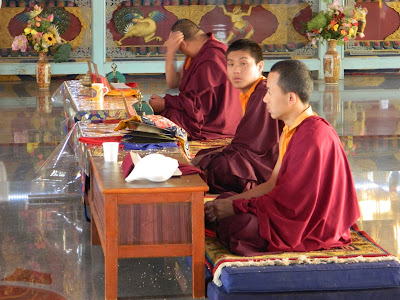Our stay in Madikeri was
coming to an end. We had one free day as a cushion after completion of
sightseeing before proceeding to our next destination, Mysore. The enchanting
view of Nilgiris, cornucopia of flora and fauna, and the chilled weather
impressed us with its aristocratic presence.
Our driver-cum-guide
requested us to see one of the rarely visited places, just around 40 km from
the headquarters of Coorg or Kodagu district called Bylakuppe. Since we had a whole day at our disposal; we accepted his request to utilize the spare day by
exploring a new destination.
How is Bylakuppe
As we proceeded through
the whispering woods, lush green meadows, our greed for a visit was enhancing
in leaps and bounds. The meandering and undulating roads ultimately led us to a
town that welcomed us with Tibetian prayer flags fluttering in tune with the
gentle breeze on the sides of the road followed by the movement of monks in
maroon and yellow robes. We just recollected our trip to Mcleodganj in Himachal
Pradesh where His Holiness Dalai Lama resided after his exile from Tibet.
As we left the vehicle
and started moving on foot, we found the entire new culture with tri-language
signboards were written in Tibetian, English, and Kannada. The outlets were mostly
managed by the Tibetian people where food, consumables, souvenirs, clothes, and
dress materials were being marketed. The place was having a different aroma
with happy faces of the population of different age groups, always smiling
despite their horrendous past. They were found to be in a relaxing mood as if
they had come out of all family knots, only devoted to their God.
History of Bylakuppe
Chinese attack on Tibet,
in the early sixties, forced the local people to leave their place and settle
in India and other parts of the world. His Holiness Dalai Lama with his
disciples settled in Mcleoganj or Upper Dharamshala in Himachal Pradesh which
had been declared as the largest Tibetian settlement in India.
Since the settlement of
Mcleodganj got saturated; the second phase of refugees came down to South India
and settled in the hills of Nilgiris, converting the place into the
second-largest Tibetian settlement in India. Though the settlement was
restricted to around 12 sq km at the initial stage, later the periphery got
extended with the increase of population. Despite the increase in population,
the serenity and tranquility of the place did not get diminished; it rather
flourished with a divine culture.
What are the places to
see
Our first target was to
visit Namdroling Monastery or locally popular as Golden Temple. It was the main
attraction of the entire township. His Holiness 3rd Drubwang
Prema Norbu Rinpoche laid the foundation stone in 1963. It was consecrated by
His Holiness Dalai Lama and the nomenclature was made by him. However,
financial hardship delayed the work till 1979 and the personal and physical
effort of Rinpoche converted to reality. The mesmerizing infrastructure and
artwork attracted tourists from various corners of the world. The monastery
started with just 10 monks now sheltered around 9000 monks and nuns. It had
become a center of study on Buddhism. Buddhists from all over the world
provided financial and moral support to grow it as a megastructure.
The center of attraction
had helped to create few more monasteries like Drigung Kagyud Monastery, Sakya
Monastery, Sera Je Monastery, and finally Tashi Lhunpo Monastery which was
founded by His Holiness Dalai Lama in 2016.
It was not the concentration of monasteries that converted the location to a place with serene
and tranquility, but the entire environment of the township seemed to be like
holy land where the existence of sin, cruelty, misconduct could not be traced.
How to Reach
Bylakuppe is situated on
NH-275 connecting Bantwal and Bengaluru touching Mysuru and Madikeri. The
distance to Bylakuppe from Bengaluru is 222 km, Mysuru is 82 km and Mangalore
is 172 km. It is also connected with Chennai and Kozhikode.
The nearest airport is
Kannur which is around 75 km away from Bylakuppe and the nearest railway
station is Krishnarajnagar which is around 58 km distance from the town.
However, the major railway station is Mysuru. It is preferred to reach directly
by road from Mysuru or Madikeri.
Where to Stay
Plenty of hotels,
hostels, homestays, and Airbnb rentals are available in the township which is of varied rates based on star ranking and
facilities provided. The majority of the visitors especially pilgrims intend to
stay near Namdroling Monastery, in the center of the town.
My Experience
The beauty of a place
was not the infrastructure, pomp, and gaiety but the manifestation of happiness
of the people as seen in their faces. That was the reason for which Bhutan had
been considered as one of the happiest countries despite their Gross Domestic
Product or Per Capita Income was much below than that of the so-called
wealthiest countries.
In other words, the place seemed to be a Vatican City of the Buddhist where the divine atmosphere
persisted round the clock and the smiling faces would make you feel to have reached
heaven where there was no existence of misery.


























